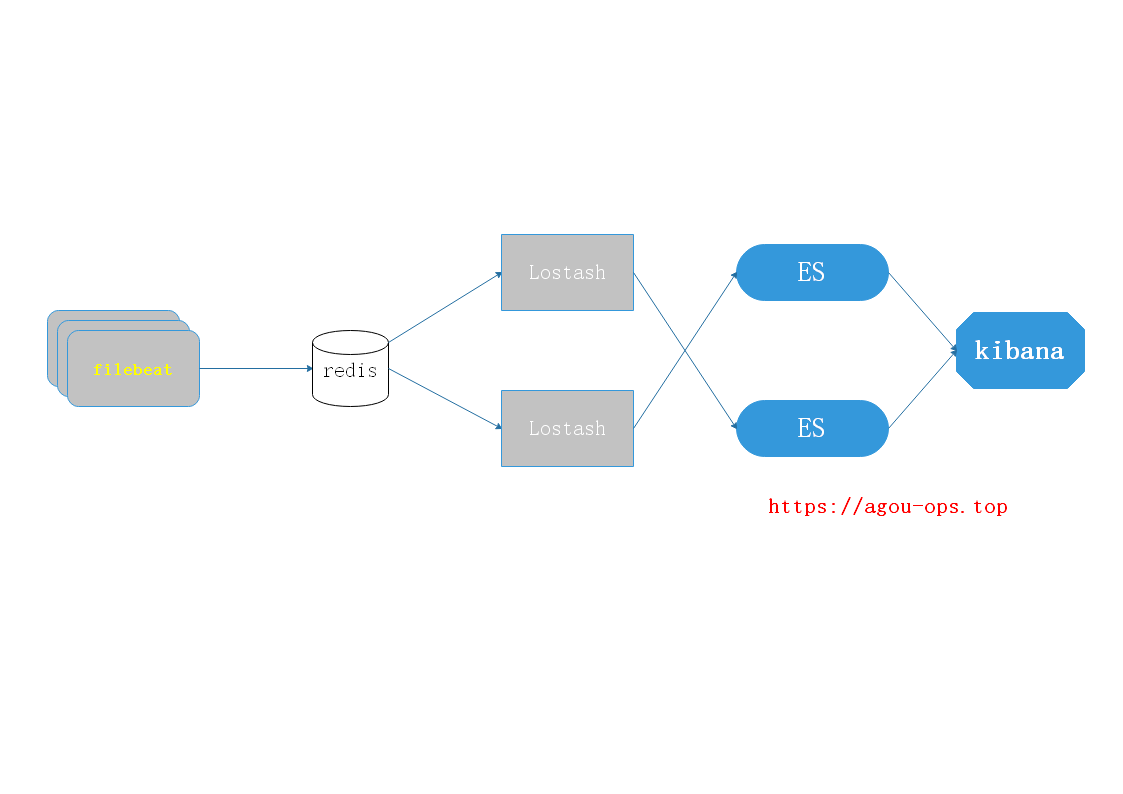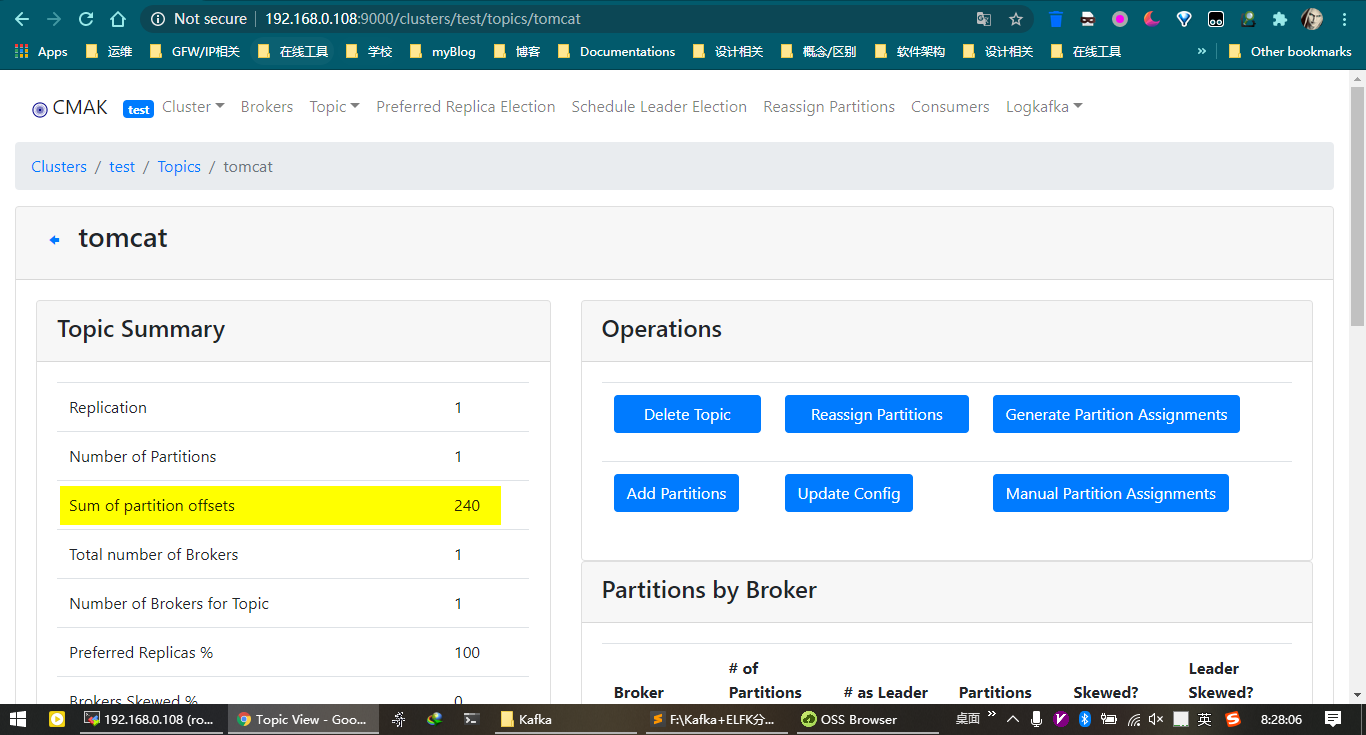# Kafka/Redis + ELFK分布式日志收集


# 使用背景
由于
ELFK的局限性,随着Beats收集的每秒数据量越来越大,Logstash可能无法承载这么大量日志的处理。虽然说,可以增加 Logstash 节点数量,提高每秒数据的处理速度,但是仍需考虑可能Elasticsearch无法承载这么大量的日志的写入。此时,我们可以考虑 引入消息队列 (Kafka),进行缓存。
# Filebeat --> Kafka/Redis
# vim /usr/local/filebeat-7.7.1-linux-x86_64/filebeat.yml
filebeat.inputs:
- type: log
paths:
- /usr/local/apache-tomcat-9.0.34/logs/tomcat_access_log.*.log
#fields:
# log_source: messages
#fields_under_root: true
output.kafka:
hosts: ["192.168.0.108:9092"]
topic: tomcat
partition.round_robin:
reachable_only: false
1
2
3
4
5
6
7
8
9
10
11
12
13
14
2
3
4
5
6
7
8
9
10
11
12
13
14
输出到redis:
# filebeat.inputs 内容和上面类似...
# 简单输出示例
output.redis:
hosts: ["localhost"] # 如果是集群, 则需要添加多个
# port: 6379
password: "my_password"
key: "filebeat"
db: 0
timeout: 5
# output.redis:
# hosts: ["localhost"]
# key: "default_list"
# keys:
# - key: "info_list" # send to info_list if `message` field contains INFO
# when.contains:
# message: "INFO"
# - key: "debug_list" # send to debug_list if `message` field contains DEBUG
# when.contains:
# message: "DEBUG"
# - key: "%{[fields.list]}"
# mappings:
# http: "frontend_list"
# nginx: "frontend_list"
# mysql: "backend_list"
1
2
3
4
5
6
7
8
9
10
11
12
13
14
15
16
17
18
19
20
21
22
23
24
25
2
3
4
5
6
7
8
9
10
11
12
13
14
15
16
17
18
19
20
21
22
23
24
25
# 启动 Kafka/Redis
这里为了方便起见,我使用docker-compose脚本来进行快速部署,脚本内容参见[使用 docker-compose 部署 Kafka](../Kafka/使用 docker-compose 部署 Kafka.md)
如果你已经安装好了kafka-manager, 可以在面板上看到相关topic已经创建, 并且写入数据之后, 已经有了分区偏移量, 如下图所示:

检测
filebeat是否将日志传递给kafka:bin/kafka-console-consumer.sh --zookeeper 192.168.0.108:2181 --topic tomcat --from-beginning1
启动redis:
systemctl start redis
1
进入redis交互式客户端进行查看(由于信息太长, 在此进行缩略显示):
127.0.0.1:6379> keys *
1) "filebeat"
127.0.0.1:6379> LPOP filebeat
"{\"@timestamp\":\"2020-07-15T14:52:07.315Z\",\"@metadata\":
...
`"GET / HTTP/1.1`\\\",\\\"status\\\":\\\"200\\\",\\\"SendBytes\\\":\\\"11216\\\",\\\"Query?string\\\":\\\"\\\",\\\"partner\\\":\\\"-\\\",\\\"AgentVersion\\\":\\\"curl/7.29.0\\\"}\",\"input\":{\"type\":\"log\"},\"host\":
...
127.0.0.1:6379> LPOP filebeat
"{\"@timestamp\":\"2020-07-15T14:52:08.339Z\",\"@metadata\":{\"beat\":\"filebeat\",\"type\":\"_doc\",\"version\":\"7.7.1\"},\"agent\":
...
`"GET/test/index.html`HTTP/1.1\\\",\\\"status\\\":\\\"200\\\",\\\"SendBytes\\\":\\\"19\\\",\\\"Query?string\\\":\\\"\\\",\\\"partner\\\":\\\"-\\\",\\\"AgentVersion\\\":\\\"curl/7.29.0\\\"}\",\"log\":{\"offset\":234,\"file\":{\"path\":\``"/usr/local/apache-tomcat-9.0.34/logs/tomcat_access_log.2020-07-15.log`
...
1
2
3
4
5
6
7
8
9
10
11
12
13
2
3
4
5
6
7
8
9
10
11
12
13
# Kafka/Redis --> Logstash --> ElasticSearch
从kafka输入:
# vim /usr/local/logstash-7.7.1/config/kafka2es.conf
input {
kafka {
codec => "json"
topics => ["tomcat"]
bootstrap_servers => "192.168.0.108:9092"
auto_offset_reset => "latest"
group_id => "logstash-g1"
}
}
output {
elasticsearch {
hosts => "http://192.168.0.108:9200"
index => "tomcat-%{+YYYY.MM.dd}"
}
}
1
2
3
4
5
6
7
8
9
10
11
12
13
14
15
16
2
3
4
5
6
7
8
9
10
11
12
13
14
15
16
从redis输入:
input {
redis {
host => "localhost"
port => "6379"
db => "0"
key => "filebeat"
data_type => "list"
password => ""
codec => "json"
}
}
# output 内容与 kafka 相似.;.
1
2
3
4
5
6
7
8
9
10
11
12
13
2
3
4
5
6
7
8
9
10
11
12
13
启动es和logstash之后, 打开浏览器, 使用插件访问elasticsearch的web管理页面, 查看是否已经收集到tomcat日志信息.

打开Kibana管理界面, 添加索引, 并在Dashboard中查看来自Logstash的日志.

# 参考链接
- configuring output: https://www.elastic.co/guide/en/beats/filebeat/current/configuring-output.html
- https://www.cnblogs.com/sanduzxcvbnm/p/11422928.html